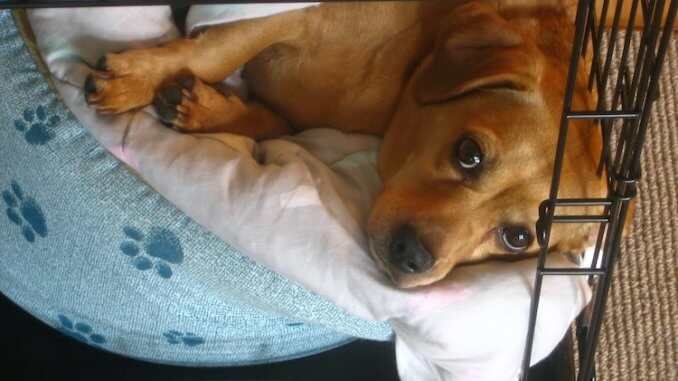
The day has finally arrived for you to welcome home a puppy.
Once your puppy arrives home, playing and establishing a routine are two of your first tasks!
A crucial part of establishing a routine is teaching them to gradually cope with periods where they will be by themselves.
This is where crate training a puppy comes in.
A crate provides your puppy with a safe and secure place that can be used to rapidly accelerate housebreaking (more on that below).
Crate training must be done gradually with the correct techniques, otherwise, your puppy can become worried, frustrated, or suffer from separation anxiety…
TABLE OF CONTENTS
What Is Crate Training? (Overview)
Crate training is the gradual process of teaching your puppy to settle and relax in the confines of a pen.
It is important you start slowly when crate training a puppy.
Train gradually at your puppy’s pace, too fast and they may learn to dislike it. Signs you are crate training too fast include:
- Barking.
- Howling.
- Scratching.
- Refusing to go in.
The time it takes to crate train a dog can be anywhere from one day to one month. Some dogs are confident and calm from day 1, while others will need more help. Most puppies can be crate trained within two weeks.
When you start crate training it is best to assume they will need more help and implement a gradual training program.
This will avoid the risk of your puppy disliking it.
A common question we are asked is: is it cruel to crate a puppy at night?
The answer is it depends.
If your puppy has got plenty of space, is able to change position easily, and has spent short periods in the pen during the day then crating your puppy overnight is not cruel and will ensure they are safe whilst sleeping unsupervised.
Why Should You Crate Train Your Dog?
There are many advantages to crate training puppies:
- It is a safe space for your puppy to retreat to when tired.
- Helps to keep them safe when full supervision cannot be given.
- Prevents practicing undesirable behaviors (e.g. chewing) when unsupervised.
- Provides a clear boundary for children to understand when not to interact with the puppy.
- Accelerates housetraining as puppies are less likely to toilet near their bed.
- Prepares puppies for vet stays as all vets will crate dogs before and after surgery.
What To Know Before Buying A Crate
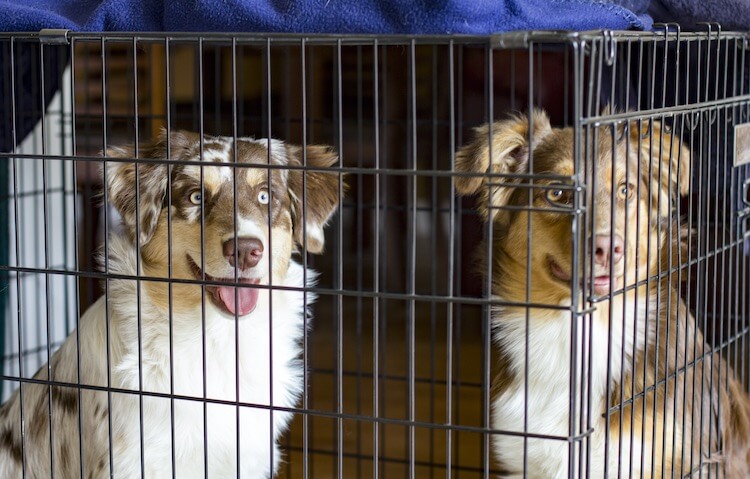
From Adobe Stock
There are many different types of dog crates available. The first thing to think about is the size. It is important to make sure you get the right size for your puppy (remembering they grow quickly).
You need to make sure your puppy can move around freely and that it’s large enough for: a bed, water bowl, toys, and space to eat meals.
If you are adopting a large breed, choose a crate with partition sections so you don’t have to purchase multiple crates as your puppy grows.
Next up, material and build quality.
There are four main materials: metal, plastic, fabric, and wooden. Fabric is normally the cheapest whereas metal and plastic are more expensive.
It is important to consider the material the crate is made from, especially for breeds that like to chew. Also, some materials are also easier to clean than others; it is more than likely that at some point your puppy will toilet in their pen.
Metal and plastic are simple to wipe clean in case of any accidents. Metal and fabric are better for pets on the go because they are quick and easy to fold.
Finally, consider the locking mechanism. Metal and plastic crates have slides across latches which are difficult to open, whereas fabric crates tend to use a zip.
Zips are very easy for puppies to scratch or chew open.
How to Crate Train a Puppy: Step by Step
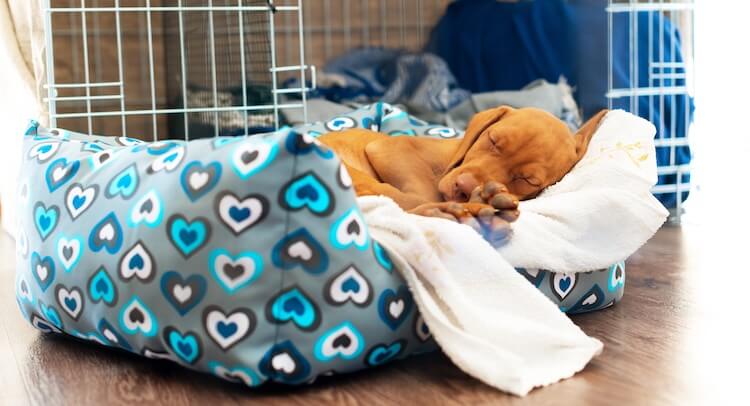
Step 1: First Time in a Crate (Days 1-2)
It is important that before you start crate training the crate is set up correctly.
Make sure you set it up when your puppy is not in the same room as it can make a lot of noise which may scare them. For the first few days, fasten the door open so it cannot slam shut and spook your puppy!
Place the crate in an area of your home where regularly spend time, but out of the way of walk-throughs and busy or noisy rooms.
The corner of a sitting room is ideal.
Make sure it is as inviting as possible. Place a snuggly blanket inside — this cute pet photo blanket would do very well. Bring a few toys inside too. You could cover the crate with a big blanket to make it feel like a den.
Your puppy’s first experience of their crate should be associated with really good things.
- Sprinkle a trail of treats leading from outside the crate to inside it.
- Then let your puppy into the room and allow him to explore and eat.
- When he finds the treats verbally praise him for doing so.
Observe what your puppy looks like when he first investigate the crate. Does he barge his way in super confidently following the food, or is he tentative and cautious?
Watching their body language will give you clues when you can progress to the next stage of crate training. You want your puppy to be happily walking in!
Intermittently throughout the day (when your puppy isn’t looking) sprinkle more treats in the crate.
Your puppy will come to think that their crate is the magical treat dispenser, and should start spending more time and being more confident around it.
Only once they are regularly searching to ‘check’ for treats, and ideally occasionally resting in there, should you progress to step 2.
This might take 1 day, or it may take two or three days. Observe your puppy closely!
Step 2: Extending Crate Time (Days 3-6)
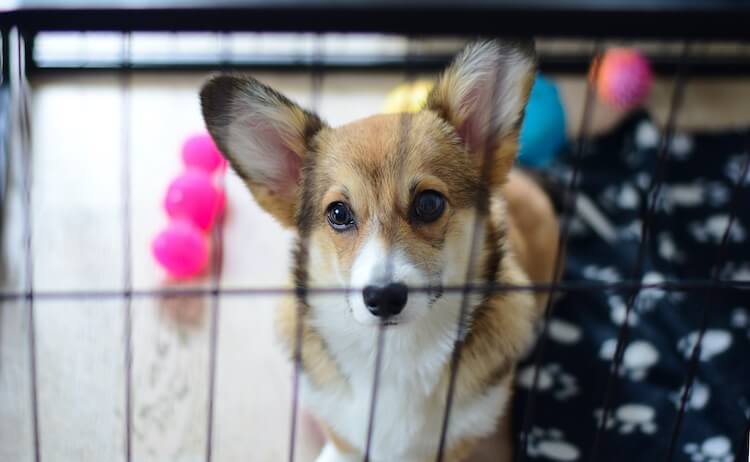
Once your puppy is confident and has discovered lots of ‘secret’ treats, you can start building up the time they spend in their crate.
You should only progress onto this stage when your puppy is happy going in and out!
The best way to extend crate time is to feed him inside it.
You should start by feeding using a slow feeder, kong, or lickimat in the crate. As you give him his meal, say ‘kennel up’ or ‘go sleep’. Over many repetitions, he will learn what these words mean. Place the food just on the inside of the crate to start with.
For each meal, put it further and further inside, but make sure you keep the door open.
Using a slow feeder will slow down mealtimes, meaning he spends more time around the crate and provides mental stimulation which will help tire him out!
Once your puppy is happy to eat his food from the crate, you can now progress to closing the door:
- Make sure your puppy has been to the toilet.
- Put his meal in the crate, wait for him to start eating, and close the door slowly behind him.
- Monitor him closely but hopefully, he’ll just carry on eating his meal.
- Stay close at this point to ensure he doesn’t panic at any point.
- Open the door just as he is finishing his meal so that he barely notices that the door was closed.
After each meal gradually extend the time that the door is closed:
- Meal #1: none
- Meal #2: 5 seconds
- Meal #3: 10 seconds
- Meal #4: 15 seconds
- Meal #5: 20 seconds
- Meal #6: 25 seconds
- Meal #7: 30 seconds
- Meal #8: 45 seconds
- Meal #9: 60 seconds
- Meal #10: 90 seconds
- Meal #11: 120 seconds
- Meal #12: 150 seconds
You may need to go slower for some puppies, while others will be happy to go faster.
The key is to monitor your puppy’s behavior.
We want him relaxed, happy, and calm – rather than whining or pawing at the door.
If your puppy does whine, avoid letting him out. He will learn to whine to be let out! Wait for a period of quiet and then open the door. Next time you feed, go back a stage or two to when he was comfortable, before building back up.
Once your puppy can cope with 10 minutes you can move to step three.
Step 3: Enjoying Crate Time (Days 7-11)
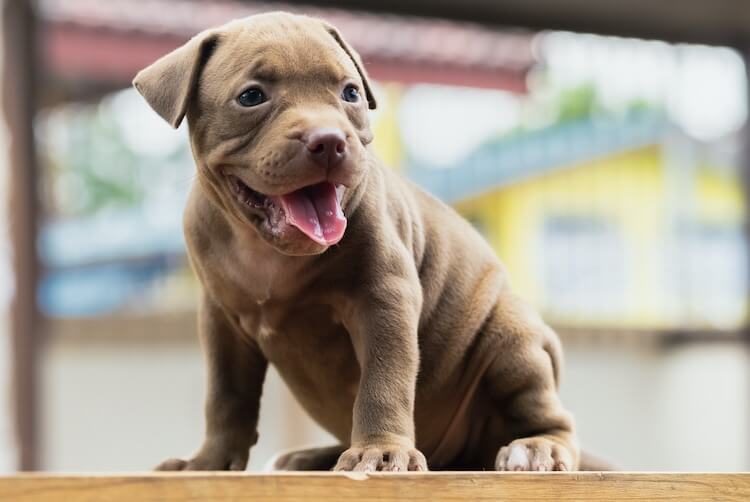
From Adobe Stock
After their first week of crate training, your puppy should be eating his meals happily inside it. Some will now understand the cue ‘go sleep’ too.
It is now time to start crating him outside of mealtimes. To start with, incorporate naps into his routine (here are some good example crate training schedules).
- Ask your puppy to ‘go sleep’.
- When they go in, praise and sprinkle some treats for him to eat.
- Close the door behind him.
- Sit quietly next to the crate with him for a few minutes.
- He should go to sleep, in which case you can briefly move away.
- If he doesn’t fall asleep, open the door after five minutes and repeat 10-15 minutes later.
- Closely monitor him as you’ll want to be present when he wakes up.
Gradually increase the time he spends in his crate during these nap times.
Do this for the next few days to build up the time he spends inside! Once he is comfortable, you can progress to leaving him alone.
- Ask your puppy to ‘go sleep’.
- When they go in, praise and sprinkle some treats for him to eat.
- Close the door behind him.
- Get up and move to the next room.
- After five minutes, return to him, sit next to him again for a few minutes and then let him out.
- Repeat this several times a day!
You will need to build up the time he is left alone gradually.
Practice leaving through various doors; start with the back door, move on to the front door, then the adjoining room.
This will help to teach him that when you go through the front door to leave for ‘real,’ it is not such a big deal!
Step 4: Leaving Home (Days 12-14)
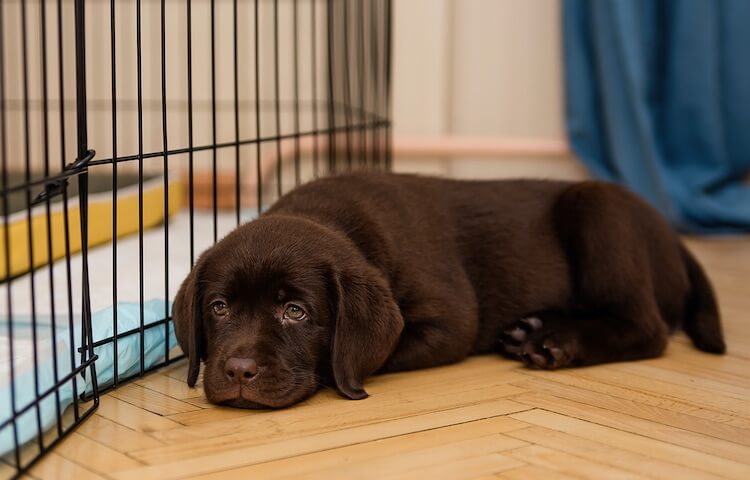
From Adobe Stock
Leaving your puppy at home can be emotional and stressful. However, it is part of normal life and our dogs need to learn to cope with being left alone.
Once your puppy has completed step three, and can rest comfortably for 30 minutes with you in a different room, you can begin crating him when you leave the house.
These departures should fit within the 30-40 minute range initially (think a quick trip to the shop, not a day out).
- Make sure the crate is comfortable and has a couple of puppy-safe toys.
- Ask your puppy to ‘go crate’.
- Give him a sprinkle of treats to reward him.
- Close the door behind him.
- Get up and leave the house.
- Avoid saying lots of ‘bye byes’, leave quickly and quietly.
It is helpful to have a pet camera set up so you can make sure your puppy is safe whilst you are away from home. A camera will also guide you when it comes to increasing the time he is by himself for. If he sleeps the majority of the time you are away, you can increase the time!
When you return home, greet your puppy calmly (no over-emotional reunions), let them out of their crate, and take them to the yard for a toilet break.
Step 5: Crate Training at Night (Day 14+)
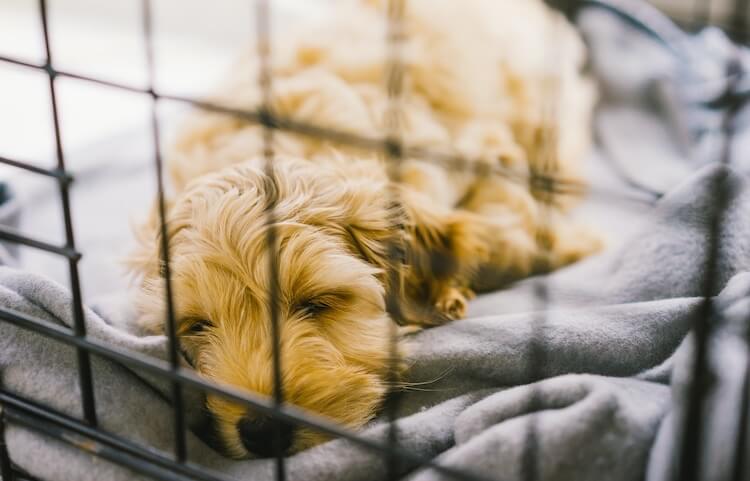
From Adobe Stock
Teaching a puppy to sleep in their crate overnight is important to avoid accidents or chewing when they can’t be supervised.
Initially start with the crate in your bedroom (ideally next to your bed).
In addition, support him with verbal and physical touch overnight until he’s asleep.
Listen out for whining in the middle of the night as this might indicate a toilet break is needed. Expect mid-night toilet breaks for the first four to eight weeks.
During your puppy’s first couple of weeks, focus on the crate training outlined above during the day.
As he gets confident with crate training during the day, you can start to move his crate further and further away from you in the evening.
See our troubleshooting section if your puppy is struggling overnight!
Puppy Crate Training Schedule
Getting your puppy into a routine is a really good idea. It will ensure your puppy is going out for regular toilet breaks (which will make housetraining much quicker) and teaches your puppy to learn what to expect and when.
Sticking to a routine also allows you to make sure your puppy is getting enough sleep. Nap times are important to avoid an over-tired puppy.
Follow our schedule below and build training in throughout the day:
Schedule For Stay At Home Parents
| Size | 17 to 20 inches |
| Weight | 45 to 70lb |
| Lifespan | 8–12 years |
| Breed Type | Non-Sporting Group |
| Purpose | Companion Dog |
| Suitable For | Adults, Families with Older Children |
| Color | Red, Black, Blue, Cinnamon and Cream |
| Temperament | Dignified, Intelligent, Loyal, Stubborn and Serious |
| Other Names | Chow, Chowdren, and Puffy-Lion Dog |
Schedule For Working Parents
| 6-8 am | Let out, toilet break Walk ½ Meal in the crate | Start with door open |
| 8-10 am | Toilet break Put puppy in crate with kong (filled with ½ Meal) Leave to nap | Video monitor to check progress/check for signs of worry |
| 10-11 am | Visitor checks on puppy Let out, toilet break Short playtime Re-settling in crate | Ensure puppy sitter can be consistent |
| 11-12 pm | Toilet break Leave to nap | Video monitor to check progress/check for signs of worry |
| 12-1 pm | Let out, toilet break Training session (recall/sit etc) Playtime with free access to pen Meal in the crate | Leave door open |
| 1-3 pm | Toilet break Put puppy in crate with kong (filled with ½ Meal) Leave to nap | Video monitor to check progress/check for signs of worry |
| 3-4 pm | Visitor checks on puppy Let out, toilet break Short playtime Re-settling in crate | Ensure puppy sitter can be consistent |
| 4-5 pm | Toilet break Leave to nap | Video monitor to check progress/check for signs of worry |
| 7-9 pm | Let out, toilet break Playtime with free access to pen Free time | Leave door open |
| 9-11 pm | Toilet break Free time Bedtime | Place crate next to bed for first two weeks Door closed |
Golden Rules
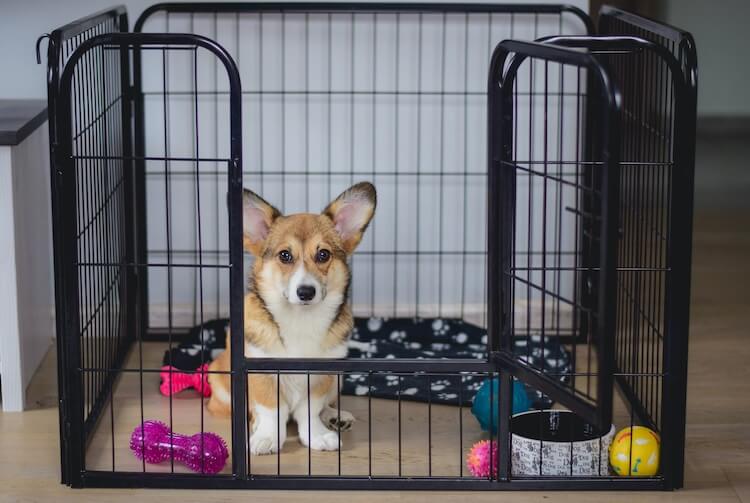
From Adobe Stock
Crate training a puppy has many benefits. It helps to provide a safe space that prevents undesirable behaviors such as toileting in the house.
However, there are some key rules you should stick to when crate training. Sticking to these rules will help ensure that your puppy doesn’t feel anxious or frustrated:
- Ensure it is big enough. Your puppy should be able to move freely around, change sleeping positions, sleep off the bed if they want to, have toys and a water bowl.
- Make it comfy and snuggly. A bed big enough for your puppy to stretch out in with plenty of blankets will ensure your puppy is not so easily disturbed when resting.
- Never force your puppy into the crate! This will create anxiety or frustration at being confined against their will and will set back your training.
- Don’t interact with your puppy whilst they are inside their crate. Don’t allow children to crawl in, or try and play with your puppy when they are resting inside.
- It should only ever be used to confine a puppy for short periods of time. Once trained, do not exceed 3 hours without a break.
- Use it from day one, this will help your puppy adjust and seek the safety of the crate early on.
- Don’t ignore crying or whining. Wait for a brief gap and then let your puppy out. We don’t want the puppy to learn that being confined is a negative thing.
- Never use it as a method of punishment.
- Confining your puppy before they have learned to enjoy it. This leads to anxiety or frustration and results in whining, barking, or howling or scratching at the gate.
- Relying on the crate to keep your puppy safe. It should not be used excessively because you don’t have time to entertain, train, socialize, or play with your dog.
- Trying to rush crate training. You should invest time during the first few weeks and do things gradually.
- Rewarding your puppy for barking by letting him out. If you let him out when he’s barking, he’ll be more likely to bark.
- Not feeding meals in the crate. Mealtimes are the perfect opportunity to develop positive associations. Don’t miss out!
Troubleshooting: Frequently Asked Questions
Can I Crate Train My Puppy On His First Night?
Yes. It is a good idea to get your puppy into the habit of sleeping in their crate overnight from day one.
However, as discussed in the ‘crate training overnight’ section, you will want to support this as much as possible with your physical presence and soothing verbal interaction.
My Dog Is Barking In His Crate At Night
If your dog is barking in his crate at night-time, firstly double-check with your vet that he’s fit and healthy.
If your puppy is barking follow our step-by-step guide above. Barking, whining, or howling are all signs you have rushed the crate training process.
My Puppy Won’t Go In Their Crate
If your puppy is very worried about the crate, don’t force the matter.
Keep to steps one and two in this guide for longer periods of time. This will help build their confidence before adding in crate training.
Reduce any clattering the crate makes when it’s stepped into by buffering the underneath with blankets.
You could also cover the rim with a soft blanket so that it’s easier to step inside. It may also be advisable to use pheromone products such as Adaptil, as this can help puppies understand they are safe.

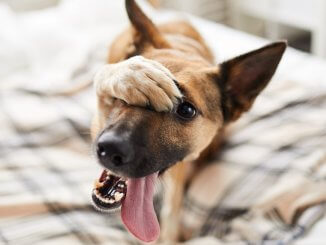


Thank you, thank you, thank you! We’re getting a puppy in the fall and I was concerned about how to crate train, you’ve relieved a lot of my fears and I’ve found this extremely informational.
If not in the crate, what do you suggest? Especially at night? Can you list alternatives?
Hi Kristi, crates are the only safe place to keep a puppy in the evening. You could try adding a playpen to the crate.
Hi! I’m someplace around step 1-2 with my 3 month old puppy. She’s not napping in the crate yet. I’m home with her so I can put the time into training. However, she’s been sleeping with us for one month. Did we ruin our chances of crate training her?! Do we keep this up while still trying to get her to the final step of sleeping overnight in the crate?? This is definitely harder than I thought. I’m exhausted! Thanks!
You say a crate is the only safe place to keep a puppy in the evening, but your guide also says not to try sleep crate training until day 14.
Where should I have him sleep until he’s ready?? He howls and cries, as I have been following a different guide and I’m not happy with it.